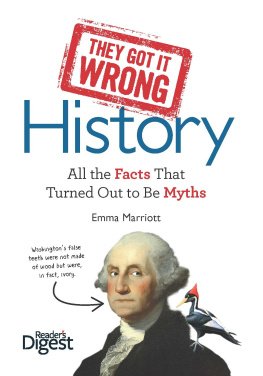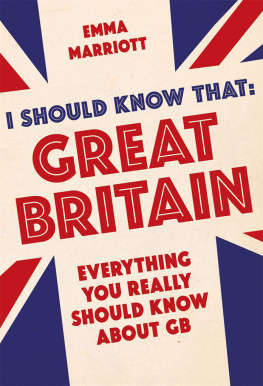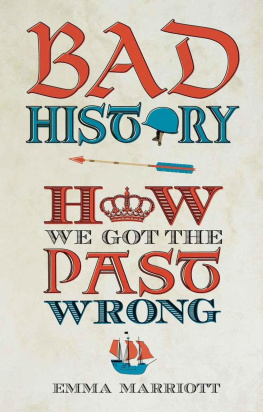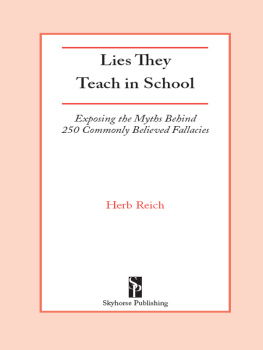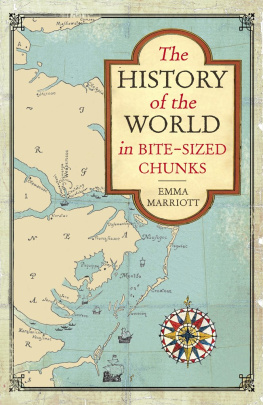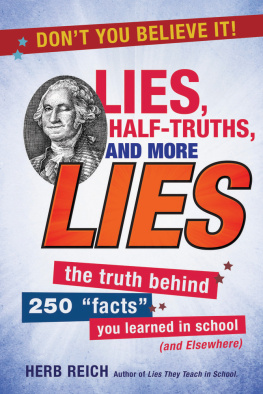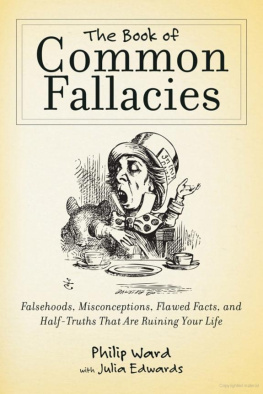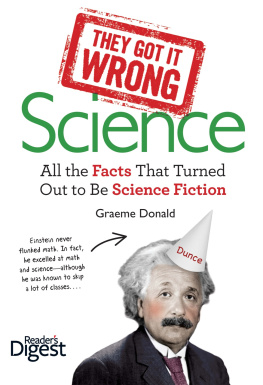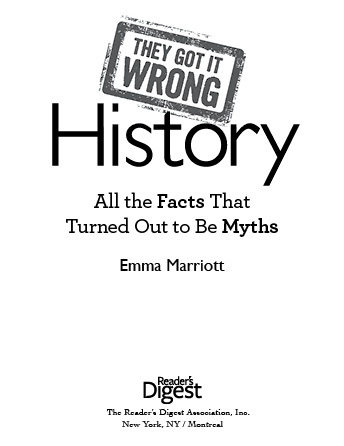
A READERS DIGEST BOOK
Copyright Michael OMara Books Limited 2013
All rights reserved. Unauthorized reproduction, in any manner, is prohibited.
Readers Digest is a registered trademark of The Readers Digest Association, Inc.
First published in Great Britain in 2011 by Michael OMara Books Limited, 9 Lion Yard, Tremadoc Road, London SW4 7NQ.
Maps and technical drawings by David Woodroofe.
Illustrations by Andrew Pinder.
Library of Congress Cataloging-in-Publication Data
Marriott, Emma.
They got it wrong, history : all the facts that turned out to be myths / by Emma Marriott.
p. cm.
First published in Great Britain in 2011 by Michael OMara Books Limited.
Includes bibliographical references and index.
ISBN 978-1-62145-008-5 (alk. paper) -- ISBN 978-1-62145-022-1 (epub)
1. History--Miscellanea. 2. History--Errors, inventions, etc. I. Title.
D10.M374 2013
909--dc23
2012035133
ISBN 978-1-62145-008-5 (hardcover)
ISBN 978-1-62145-087-0 (paperback)
ISBN 978-1-62145-022-1 (epub)
We are committed to both the quality of our products and the service we provide to our customers. We value your comments, so please feel free to contact us.
The Readers Digest Association, Inc.
Adult Trade Publishing
44 South Broadway
White Plains, NY 10601
For more Readers Digest products and information, visit our website:
www.rd.com (in the United States)
www.readersdigest.ca (in Canada)
Introduction

History is a pack of lies about events that never happened told by people who werent there.
George Santayana
The chronicles of history are littered with myths and legends, misinformation, falsehoods, embellishment, wild exaggeration, and a whole lot of confusion. All this makes for an awful lot of bad history. As Mr. Santayana says, the problem with history is that we werent actually there, and we rely on other people who also werent there to tell us what happened and why. This means that historical factslike the ones drilled into us at schoolare not quite what they seem. The best we can say for a lot of them is that they are probably true, while otherslike that Lincolns main goal of the Civil War was the emancipation of the slaves or that St. Patrick was Irishturn out to be, well, probably not true.
There are a myriad of reasons why events or people from the past are misrepresented or misunderstood. Archaeological or documentary evidence may be lacking, unreliable, or bewilderingly inconsistent (ask ten or twenty witnesses what happened at a particular incident, and youll get ten or twenty different versions). Extrapolating what happened at any given event is a tricky business. If you then add in a large chunk of time, be it a decade or several centuries, some might say its an almost impossible task.
Problems also arise when we wrench something out of the past and examine it out of context. We cant pretend we dont live in the present, and no matter how much we try, modern sensibilities shape our view of historyand the conclusions that we draw often speak volumes about our own beliefs. In the last century, Captain Scott was revered as a great explorer; now many think of him as an ill-advised fool. Which is it to be? And which is the example of bad history?
History, like life, is annoyingly complex (and confusing); so packaging the past into a neat story so that it fits some kind of preconceived notion has its dangers. We liken our historical figures to imaginary characters, and assign to them the familiar stereotypes of either hero or villain. We forget, however, that they were real-life people, who, like us, were probably a combination of good and bad. We much prefer our victories in battle to be resounding and decisive, and not, like many military engagements, muddled, open-ended, and inconsequential. While these embellishments make for exciting storieswe all love a dashing hero or a resounding victorythey also distort the truth, endorse delusions of grandeur, and perpetuate many of the myths with which we are so familiar.
Historical myths, like fairy tales, are generally quite harmless, but when they are seized upon as political weaponry, the consequences can be disastrous. Repressive regimes can cover up a discreditable past or rewrite the history books with their own sanitized version of events (see ).
What follows is an investigation into some of the myths and falsehoods that have become entrenched in popular belief and wrongly influenced our understanding of the world. It is by no means exhaustivethere are without a doubt many more myths out therebut I hope it goes some way to shedding light on some of the worst offenses. Some will disagree with the findingsI too wasnt there, and, as the historian Pieter Geyl said (at least, I hope he said it), History is an argument without end. But Im hoping that the history passed down to us is not all a pack of lies, that lurking within what they got wrong are some truthswe just need to keep looking for them.
Emma Marriott

The Old West was a wild and dangerous place to be.
Few areas of history have gripped the imagination as much as the expansion of the United States into the wilderness of the West. Sensational tales of the Wild West portrayed a violent and brutal land where hardy settlers rubbed alongside brave cowboys, ruthless outlaws, and savage Indians, where people took the law into their own hands to protect their families.
This image of the Old West proved hugely popular and was consolidated in folklore, music, and dime novels that sold millions of copies in the second half of the nineteenth century. Soldier and showman Buffalo Bill Cody similarly popularized the legend of the frontier through his Wild West shows. In 1893, Buffalo Bills show featured a new act of Rough Riders consisting of marksmen from all over the worldincluding future President Theodore Roosevelt.
In the twentieth century, the legend of the Wild West spread to the rest of the world as artists, magazines, and movies spun a whole industry around its mythologization, in which gun-slinging heroes battled against Injuns in places where, as Sergio Leone put it, life has no value. The first Western movie, The Great Train Robbery, came out in 1903, and by the 1950s, the genre was also lapped up by television audiences, who could choose from no fewer than twenty-six prime-time Western series in 1959.
Yet the reality of life in the West was quite different from the general lawlessness depicted in the movies. Recent research has shown that crime was relatively low among the Wests settlers and that you were more likely to be gunned down in Victorian London than in the Wild West. In the real Dodge City, which at one point was thought of as the biggest and rowdiest town of the Wild West, a total of five deaths in 1878 amounted to the towns worst year for homicides.
Similarly, the legendary shoot-out at the O.K. Corrala gunfight between two gangs led by Wyatt Earp and Ike Clanton (and regarded as the most famous gun battle in the history of the Old West)lasted all of sixty seconds and resulted in just three deaths. Face-offs at high noon were not common events, and gunfights were usually spontaneous and the result of drunken arguments that had got out of hand. The Wild West mythmakers would also have us believe that bank robberies were everyday events, but Larry Schweikart of the University of Dayton has estimated that between 1859 and 1900 just twelve bank robberies occurred along the Western frontier.

